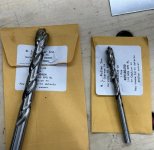Packard
Member
Michael Kellough said:Also note that a “spur bit” isn’t exactly the same as a brad point drill.
The spur bit center point is more robust (more like the bullet point) and is less susceptible to following misleading end grain.
But the image looks like a brad point bit.








